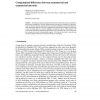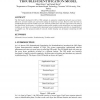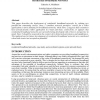4998 search results - page 169 / 1000 » The case for intentional networking |
NIPS
1998
14 years 11 months ago
1998
Symmetrically connected recurrent networks have recently been used as models of a host of neural computations. However, biological neural networks have asymmetrical connections, at...
71
Voted
NIPS
1996
14 years 11 months ago
1996
It is shown that conventional computers can be exponentially faster than planar Hopfield networks: although there are planar Hopfield networks that take exponential time to conver...
CORR
2010
Springer
14 years 10 months ago
2010
Springer
The OSI model, developed by ISO in 1984, attempts to summarize complicated network cases on layers. Moreover, network troubles are expressed by taking the model into account. Howe...
ACJ
2002
14 years 10 months ago
2002
This paper describes the deployment of residential broadband networks by relating two parallel but contrasting stories. Story 1 considers network providers' search for a kill...
NETWORKING
2004
14 years 11 months ago
2004
Abstract. In computer networks (and, say, transportation networks), we can consider the situation where each user has its own routing decision so as to minimize noncooperatively th...



